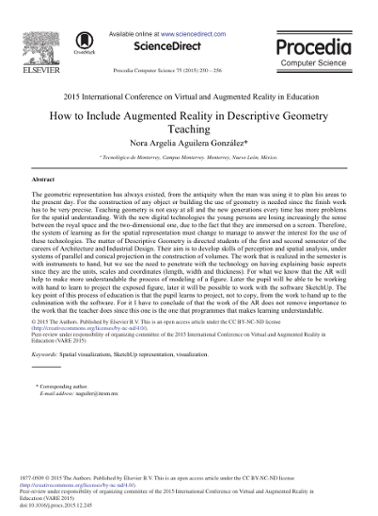| dc.creator | Nora Argelia Aguilera González | |
| dc.date | 2015 | |
| dc.date.accessioned | 2018-10-18T21:21:56Z | |
| dc.date.available | 2018-10-18T21:21:56Z | |
| dc.identifier.issn | 18770509 | |
| dc.identifier.doi | 10.1016/j.procs.2015.12.245 | |
| dc.identifier.uri | http://hdl.handle.net/11285/630437 | |
| dc.description | The geometric representation has always existed, from the antiquity when the man was using it to plan his areas to the present day. For the construction of any object or building the use of geometry is needed since the finish work has to be very precise. Teaching geometry is not easy at all and the new generations every time has more problems for the spatial understanding. With the new digital technologies the young persons are losing increasingly the sense between the royal space and the two-dimensional one, due to the fact that they are immersed on a screen. Therefore, the system of learning as for the spatial representation must change to manage to answer the interest for the use of these technologies. The matter of Descriptive Geometry is directed students of the first and second semester of the careers of Architecture and Industrial Design. Their aim is to develop skills of perception and spatial analysis, under systems of parallel and conical projection in the construction of volumes. The work that is realized in the semester is with instruments to hand, but we see the need to penetrate with the technology on having explaining basic aspects since they are the units, scales and coordinates (length, width and thickness). For what we know that the AR will help to make more understandable the process of modeling of a figure. Later the pupil will be able to be working with hand to learn to project the exposed figure, later it will be possible to work with the software SketchUp. The key point of this process of education is that the pupil learns to project, not to copy, from the work to hand up to the culmination with the software. For it I have to conclude of that the work of the AR does not remove importance to the work that the teacher does since this one is the one that programmes that makes learning understandable. © 2015 The Authors. | |
| dc.language | eng | |
| dc.publisher | Elsevier | |
| dc.relation | https://www.scopus.com/inward/record.uri?eid=2-s2.0-84964030210&doi=10.1016%2fj.procs.2015.12.245&partnerID=40&md5=fcbb535e5e4645e1675650490bd4e532 | |
| dc.relation | Investigadores | |
| dc.relation | Estudiantes | |
| dc.rights | info:eu-repo/semantics/openAccess | |
| dc.rights.uri | http://creativecommons.org/licenses/by-nc-nd/4.0 | |
| dc.source | Procedia Computer Science | |
| dc.subject | Augmented reality | |
| dc.subject | Flow visualization | |
| dc.subject | Geometry | |
| dc.subject | Product design | |
| dc.subject | Teaching | |
| dc.subject | Descriptive geometry | |
| dc.subject | Digital technologies | |
| dc.subject | Geometric representation | |
| dc.subject | Know-that | |
| dc.subject | SketchUp representation | |
| dc.subject | Spatial analysis | |
| dc.subject | Spatial representations | |
| dc.subject | Spatial visualizatiom | |
| dc.subject | Education | |
| dc.subject.classification | 7 INGENIERÍA Y TECNOLOGÍA | |
| dc.title | How to Include Augmented Reality in Descriptive Geometry Teaching | |
| dc.type | Conferencia | |
| dc.identifier.volume | 75 | |
| dc.identifier.startpage | 250 | |
| dc.identifier.endpage | 256 | |
| refterms.dateFOA | 2018-10-18T21:21:56Z | |

